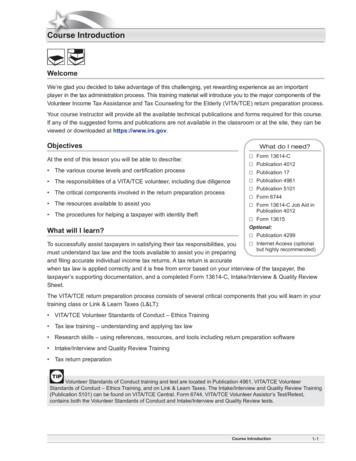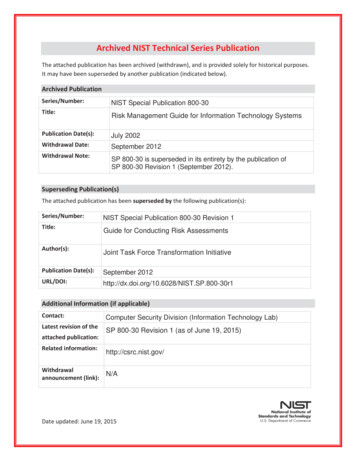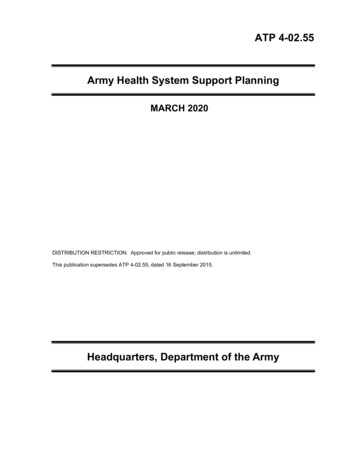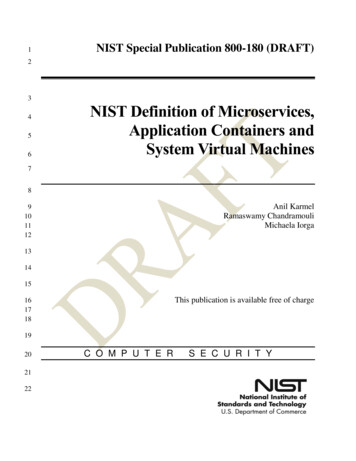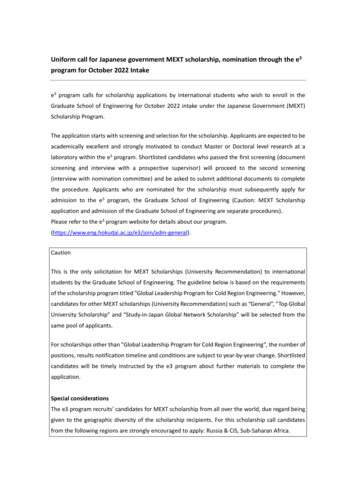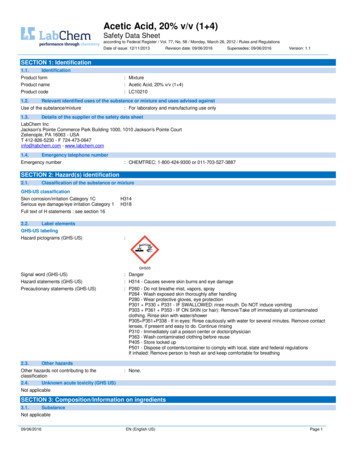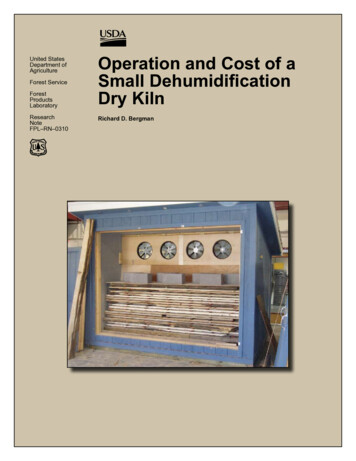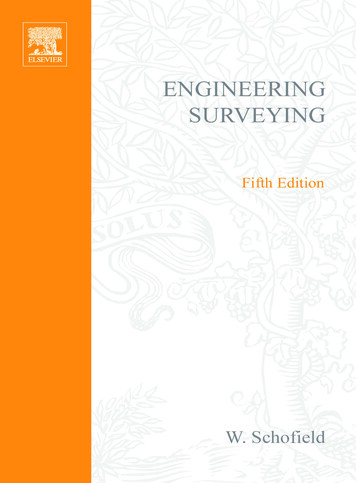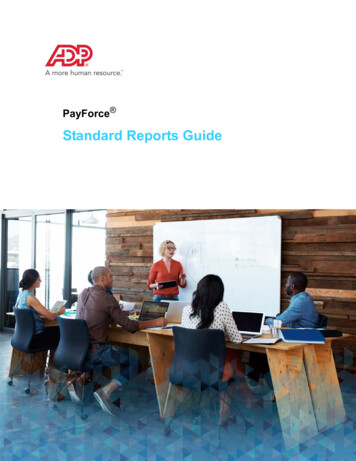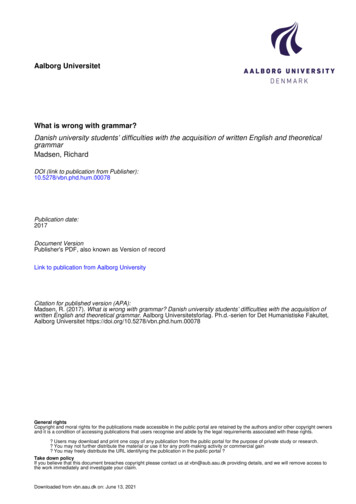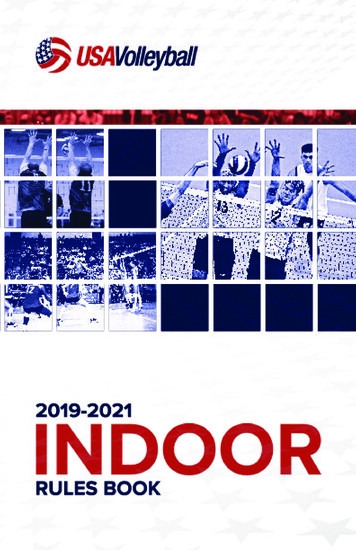
Transcription
1
This publication is available on the USA Volleyball website. 2019 USA VolleyballAll rights reserved. No part of this book may be reproduced or transmitted in anyform by any means, electronic, mechanical, photocopying, recording, or otherwise,without the prior written permission of the publisher. For more information on gettingpermission for reprint and excerpt, contact:4065 Sinton Rd, Suite 200 Colorado Springs, Colorado 80907Phone: (719) 228-6800Fax: (719) 228-6899postmaster@usav.orgISBN-97: 978-0-9914950-4-72
Rules of the Game as authorized by the International Volleyball Federation (FIVB) atthe 35th FIVB Congress, Buenos Aires, Argentina, 2016 and amended.Published by USA Volleyball.USA Volleyball has officially approved the modifications presented in this documentin order to promote the sport and encourage continuity of play at the variousorganizational, local and recreational levels across the country.For the official international rules of the game, which are used worldwide anddeveloped and approved by the FIVB, please visit www.fivb.org or our web site atwww.usavolleyball.org.USA Volleyball embraces this view, joining with all of its global partners to enablepleasurable participation from the broadest base of recreational play, to the highestlevels of international competition.Volleyball can enrich the lives of all who play and watch it. It should be fun.WE COMMIT THE RULES TO THIS END.3
ACKNOWLEDGMENTSThe Rules Commission and USA Volleyball would like to express their appreciationto the many individuals and organizations for their assistance in the editing of andproviding information for this publication.Official Hand Signals courtesy of the Federation Internationale de Volleyball, 2019 FIVB.Diagrams 1-10 reproduced by authorization of the Federation Internationale deVolleyball, 2019, FIVB.Special thanks go to Brian Hemelgarn, Stephen Shepherd, Julie Voeck, RachaelStringer, and Cindy Compoc.4
Modifications. 8Rules Interpretation. 8Information For Hearing-Impaired Volleyball Players. 8Information For Physically Challenged Volleyball Players. 9Usa Volleyball Rules Commission Volleyball Committee 2019. 9Usa Volleyball Staff Liaison. 10Significant Rules Changes And Clarifications. 11Game Characteristics. 14Philosophy Of Rules And Refereeing. 14Ball Handling Guidelines. 16Spectator/Parent Code Of Conduct. 16SECTION IORDER OF THE RULES:THE GAMECHAPTER 1FACILITIES AND EQUIPMENTRule 1. Playing Area. 20Rule 2. Net And Posts. 23Rule 3. Balls. 26CHAPTER 2PARTICIPANTSRule 4. Teams. 27Rule 5. Team Leaders. 31CHAPTER 3PLAYING FORMATRule 6. To Score A Point, To Win A Set And The Match. 36Rule 7. Structure Of Play. 38CHAPTER 44PLAYING ACTIONSRule 8. States Of Play. 44Rule 9. Playing The Ball. 45Rule 10. Ball At The Net. 47Rule 11. Player At The Net. 48Rule 12. Service. 50Rule 13. Attack Hit. 53Rule 14. Block. 54CHAPTER 5INTERVALSRule 15. Interruptions. 56Rule 16. Game Delays. 615
Rule 17. Exceptional Game Interruptions. 62CHAPTER 6THE LIBERO PLAYERRule 19. The Libero Player. 65CHAPTER 7PARTICIPANTS’ CONDUCTRule 20. Requirements Of Conduct. 70Rule 21. Misconduct And Its Sanctions. 70SECTION IITHE REFEREES, THEIR RESPONSIBILITIES ANDOFFICIAL HAND SIGNALSCHAPTER 8REFEREESRule 22. Refereeing Corps And Procedures. 76Rule 23. 1St Referee. 77Rule 24. 2Nd Referee. 79Rule 25. Scorer. 82Rule 26. Assistant Scorer. 83Rule 27. Line Judges. 84Rule 28. Official Signals. 86SECTION IIIORDER OF THE RULESDIAGRAMSCourt Diagrams. 90Official Hand Signals. 101Definitions. 110U-Volley Rules. 111Co-Ed Rules. 112Guide To Physically Challenged Volleyball. 114OFFICIATING TECHNIQUES, POINTS OF EMPHASIS &MATCH PROCEDURESReferee Techniques. 120Referee Points Of Emphasis. 125Basic Match Procedures For Referees. 1286
INSTRUCTIONS FOR USING THE OFFICIAL USAV INDOORSCORE SHEETSInstructions. 135Deciding Set Scoring Procedures. 161National Championship Tournament Procedures. 173National Scorers Will Use The Following TechniquesAnd Procedures Assistant Scorer Responsibilities. 174Explanation Of Scoring Example. 186Non-Deciding Set Scoring ProceduresDeciding Set Scoring Procedures. 204BASIC PROCEDURES FOR CONDUCTINGUSAV COMPETITIONSGuidelines For Conducting Indoor Tournaments/Leagues. 220Guidelines For Dealing With Blood. 227Concussion Guidelines. 227American Sign Language (Asl) Interpreter Guidelines. 228Abbreviations. 228Metric Conversions. 228Index (in process)7
MODIFICATIONSFor all designated international competitions, the FIVB rules will be fully in effect. Inaddition, the original FIVB rules are used at the highest levels of competition (such asAdult Open Divisions and High Performance) unless otherwise noted in the SpecificCompetitions Regulations. Modifications and clarifications in the gray boxes apply toall other levels of competition.EXAMPLE:USAV 1.1a: The playing court is a rectangle measuring 18 x 9 m (59’ x 29’6”surrounded by a free zone, which may be a minimum of 2 m (6’63/4”).USA Volleyball recognizes that there are circumstances where grassrootsdevelopment, sport development, safety or insurance requirements would indicatea need for a temporary rule modification (e.g., the number of substitutions might beexpanded to include more participants at a school or recreational level).Acknowledging that a rule may not be changed, in instances where the USAV memberorganizations feel that the promotion of the sport would be enhanced by temporaryadjustments, they are encouraged to promote the advancement of the sport.Suggestions for additional changes or temporary adjustments for inclusion in thisdocument may be transmitted through members of the Rules Commission, regionalofficials’ chairpersons or commissioners during the season. Explanation and rationaleof proposed modifications must be in the chair’s hands before Feb. 1, 2020, if theyare to be considered at the 2020 annual meeting of the Rules Commission and beforeFeb. 1, 2021 if they are to be considered at the 2021 annual meeting.RULES INTERPRETATIONQuestions regarding interpretation of the present rules and current practices may beaddressed to USA Volleyball Rules Interpreter Bill Stanley, 2601 Kelly Drive, Bellevue,NE 68123, Phone: Cell (402) 880-3891, Email: vbinterp@usav.org. Contact by email ispreferred (vbinterp@usav.org); however, you may enclose a self-addressed, stampedenvelope with your inquiry for prompt return. All inquiries will receive replies. Somequeries may involve consultations, but answers will be forwarded as soon as possible.For information relevant to the interpretation and application of the rules-specificmatch situations, please consult the USA Volleyball web site atwww.usavolleyball.org.INFORMATION FOR HEARING-IMPAIRED VOLLEYBALL PLAYERSFor additional information on the USA Deaf Volleyball Association or USA Deaf SportsFederation, contact:Patrick O’BrienPO Box 2193, Bowie, MD 20718-2193Email: pobrien@usadeafsports.org orUSA Deaf Sports FederationPO Box 22011, Santa Fe, NM 87502-2011Email: homeoffice@usdeafsports.orgWeb Site: www.usdeafsports.org/volleyball8
TT (605) 367-5761, (605) 367-5760, FAX: (605) 782-8441Dial 711 for voice calls and give relay operator the TT number above.To obtain a copy of Volleyball in American Sign Language, which illustrates more than40 of the most important volleyball terms, contact USA Volleyball at 855-USVOLLEYor info@usav.org.INFORMATION FOR PHYSICALLY CHALLENGED VOLLEYBALL PLAYERSFor additional information on the Men’s and Women’s Sitting Volleyball NationalPrograms for the physically challenged, contact:Bill HamiterHigh Performance Director, Sitting Program Head CoachWomen’s National Sitting Team100 N. University Drive, Box 99Edmond, OK 73034Phone: (405) 974-3138; Fax: (405) 974-3808; Email: bill.hamiter@usav.orgFor additional information on grassroots programs (find a place to play, create a newprogram, etc.), contact:Elliot BlakeSitting Volleyball Manager100 N. University Drive, Box 99Edmond, OK 73034Phone: (405) 974-3153; FAX: (405) 974-3808; Email: elliot.blake@usav.org.INFORMATION FOR SPECIAL OLYMPICS VOLLEYBALLFor additional information on Special Olympics Traditional, Modified and Unified Sports Team Volleyball and Individual Skills Volleyball Programs, please contact:Special Olympics North AmericaCraig Pippert3712 Benson Dr., Suite 102Raleigh, NC 27609Phone: (919) 785-0702; FAX: (919) 782-3311; Email: cpippert@specialolympics.orgUSA VOLLEYBALL RULES COMMISSION VOLLEYBALL COMMITTEE 2019*Chair: Julie Voeck, 6905 Wellauer Drive, Wauwatosa, WI 53213(Phone: 414-305-7454, Email: jvoeck@runbox.com)*FIVB Rules of the Game Commission: Pat Powers, 153 Phoebe St, Encitas, CA92024 (Phone: 760-635-3994, Cell: 760-473-8236, Email: pat@vbclinics.com)*USA Volleyball Indoor Rules Interpreter: Bill Stanley, 2601 Kelly Dr., Bellevue, NE68123 (Cell: 402-880-3891, Email: hopsinc@cox.net or vbinterp@usav.org)USA Volleyball Beach Rules Interpreter: Glenn Sapp, 7950 Dudley Ct., Arvada, CO80005 (Cell: 720-289-5797, Fax: 303-782-5577, Email: sappvb@aol.com)*USA Volleyball Indoor Regional Volleyball Association Representative: KevinWendelboe, 3770 Clemmons Rd., Suite C, Clemmons, NC 27012(Work: 336-766-3581, Fax: 336-766-3501, Email: ceo@carolinaregionvb.org)9
*USA Volleyball Beach Regional Volleyball Association Representative: Cindy M.Compoc, 22617 76th Ave W, Suite 201, Edmonds, WA 98026 (Work: 425-673-4103,Fax: 425-673-4293, Email: cindycompoc@psrvb.org)*Junior Indoor Girls Representative: Walt Weaver, 16616 Isosceles Ave., Lakeville,MN 55044 (Phone: 952-892-1721, Cell: 612-720-4278, Email: weavermvi@charter.net)*Junior Indoor Boys Representative: Aric Anderson, 11526 Wickersham Lane,Houston, TX 77077 (Cell: 714-924-5297, Email: sgrep02@yahoo.com)*Junior Beach Representative: Lisa DiGiacinto, 114 Broadview Blvd., Glen Burnie,MD 21061(Phone: 410-768-4746, Email: commissioner@chrva.org)*World ParaVolley: Joe Campbell, 16305 Lewis St., Jersey Village, TX 77040(Home: 713-856-5565, Cell: 713-702-9516, Email: iokepa1@yahoo.com)*10 voting membersNON-VOTING REPRESENTATIVESNCAA Women’s Representative: VacantNFHS Representative: Lindsey Atkinson, NFHS, P.O. Box 690, Indianapolis, IN46206 (Phone: 317-822-5730, Fax: 317-822-5700, Email: latkinson@nfhs.org)PAVO Representative: Brian Hemelgarn, 2715 W. Stein Road, La Salle, MI 48145(Cell: 419-410-2291, Email: Hemelgarn@ovr.org)INVITED GUESTSAAU Representative: Joyce Cooney, 6816 Cottage Grove Lane, Apt. D, St. Louis,MO 63129-3953 (Phone: 314-846-5149, Email: acevbc@aol.com)NAIA Men’s and Women’s Representative: Donan Cruz,Grand View University, 1200 Grandview Ave., Des Moines, IA 50316(Work: 515-263-6137, Cell: 808-386-2318, Email: dcruz@grandview.edu)NCAA Men’s Representative: Ron Shayka, George Mason University, 4400University Drive, Fairfax, VA 22030 (Phone: 703-993-2809,Fax: 703-993-3533, Email: rshayka@gmu.edu)NCVF Representative: Dan Kitchel, 1710 Stirling Ave., Lansing, MI 48910 (Phone:517-372-2204, Cell: 517-449-5431, Email: dkitchel@ncvfvolleyball.org)Special Olympics, Incorporated: Rick Laskey, 128 Troy Ave., Jacksonville, NC28540 (Phone: 910-545-9171, Email: rlaskey@earthlink.net)YMCA Representative: Nicole Limoges, YMCA, 4500 E. Kentucky Ave., Glendale,CO 80246 (Phone: 303-639-4712, Email: nlimoges@denverymca.org)USA VOLLEYBALL STAFF LIAISONDirector of Officials Development: Pati Rolf, USA Volleyball, 4065 Sinton Rd., Suite200, Colorado Springs, CO 80919 (Cell: 262-510-6771,Work: 719-228-6887, Email: pati.rolf@usav.org)10
SIGNIFICANT RULES CHANGES AND CLARIFICATIONSNew USAV 4.1.1b: A team may consist of a maximum of 15 players and five coaches/staff personnel (unless modified by the Specific Competition Regulations). AnAmerican Sign Language (ASL) interpreter may be included among the coaching staffor team personnel; see ASL Interpreter Guidelines.New USAV 4.1.1c: A complete junior team consists of a minimum of six players and aUSAV certified juniors’ coach.New USAV 4.1.2: The Libero can be team or game captain.USAV 4.3a: A player’s uniform consists of a jersey and shorts or athletic/sport pants.When undergarments, including but not limited to T-shirts, boxer shorts, tights,leotards, body suits, bicycle shorts, sports bras, etc., are worn in such a manner thatthey are exposed, they will be considered a part of the uniform. In that case, they mustbe similar and the same color for any team members (except the Libero) who wearsuch an undergarment. Socks and sport shoes are not part of the uniform.New USAV 4.3b: The legality of a team’s uniform(s) is not grounds for a protest bytheir opponent. The determination of a team’s uniform legality is the responsibility ofthe match referee(s), head referee(s), and/or tournament staff.USAV 4.3.1: The color and design for the jerseys and shorts or athletic/sport pantsmust be uniform for the team (except for the Libero).USAV 4.3.5: For nationally sanctioned competition, uniforms must be identical withthe exception of sleeve length and the Libero players. An exception will also be madefor a single manufacturer’s logo or trademark on the outside of the jerseys or shorts,provided that the logo or trademark does not exceed 14.6 square cm (2 1/4 squareinches). Sponsor logos are permitted provided they are identical on each uniform anddo not obstruct the view of the uniform number.USAV 4.5.1: It is forbidden to wear hats or casts (even if padded). Braces, prostheticlimbs or other headgear that may cause an injury or give an artificial advantage tothe player must not be worn. If a brace, prosthetic limb or headgear is used, paddingor covering may be necessary. Jewelry may be worn provided its nature does notpresent a concern for safety, such as extremely long necklaces and/or necklaces withlarge medallions, or large hoop earrings.USAV 5.1.2.1: Protests to be considered by the 1st referee (or a Protest orTournament Committee) include: 1) misinterpretation of a playing rule, 2) failure of the1st referee to apply the correct rule to a given situation, 3) failure to charge the correctpenalty-sanction for a given fault, or 4) a scoring discrepancy.USAV 5.1.2.2: For nationally sanctioned competition, the coach may act in place ofthe game captain to perform the functions stated in 5.1.2.1 and 5.1.2.2. The coachis not permitted to cross the court to speak with the 1st referee. The 1st refereemay leave the stand to address a coach near the team bench, if necessary, when acertified, professional 2nd referee is not assigned to the match.USAV 6.4: Matches that are two sets out of three will have a match result of 0-2 or 1-2depending when the default occurs.USAV 6.4.2: If failure to adhere to Rule 6.4.2 is due to insufficient players on a teamto begin a match, the team forfeits the first set at match time. After a team forfeitsthe first set of a match, an interval of up to 10 minutes shall be allowed for the teamto produce sufficient players to play the next set. If the team is complete (per USAV11
4.1.1c) prior to the expiration of this interval, the late team will be permitted use of thefull court for a four-minute warm-up before play begins. If, after the 10-minute intervalthe team is not complete, the second set shall be declared a forfeit. If the matchconsists of the best three out of five sets, an additional 10-minute interval shall beallowed before the match is declared a forfeit.New USAV 7.1.1: Multiple team representatives may attend the captains’ meeting withthe team captain. The 1st referee will confirm which player will represent the team forthe toss.New USAV 7.3.4: If a team submits a line-up sheet that lists a player’s number asboth a Libero and as a starting player, the coach or captain shall immediately decidewhether that player will be a Libero or a starting player. If the duplicate number willbe a Libero, the coach must correct the line-up but only in the starting positionwhere the Libero’s number was recorded. If the duplicate number will be the startingplayer, another player may immediately be designated as Libero. The team will not becharged a substitution.New USAV 8.4.2b iv: The ball contacts the ceiling or any obstruction after the team’sthird hit.USAV 9b: When competition is scheduled or is occurring on adjacent court(s), it is afault for a player to enter the adjacent court(s) to play a ball or after playing a ball. Thefree zone, including the service zone on an adjacent court, is a playing area. Adjacentcourts may not share the same service zone.New USAV 12.3: In addition to the above, when playing on a portable playing surface,the server shall have at least part of both feet in contact with the playing surfacebefore the 1st referee authorizes the service. After the 1st referee authorizes theservice, if the server steps entirely off the playing surface with one or both feet, it is aservice fault (Signal 22). See USAV 12.4.3.USAV 12.4.3: In addition to the above, the service hit must take place on the playingarea.USAV 12.4.5: After the whistle for the service, requests for game interruption, i.e.,time-out, substitution, may not be considered until after the ball has been served andthe rally completed, including a re-serve. A re-serve is part of a single effort to serve,and no requests will be honored during a re-serve. A request for line-up check ispermitted when the result of a rally is a replay.New USAV 15.7a: An exceptional substitution is not counted as an individual entry oras part of the total team substitutions.New USAV 15.10.3a: A verbal request for substitution is not acknowledged bythe referees. The substitute must enter the substitution zone for the request to beacknowledged, except for a substitution related to an injury.USAV 17.1.1: Should a serious accident occur while the ball is in play, the refereesmust stop the game immediately and permit medical assistance to enter the court.The rally is then replayed. If the injured player cannot continue playing within areasonable amount of time, the player must be replaced by substitution, a legal Liberoreplacement (if the Libero is not on the court at the time of the injury), or the teammust take a legal time-out.USAV 17.1.1 a: If the referees are informed that a substitute will replace the injuredplayer, no time-out will be charged regardless of the time required to safely removethe player from the playing area.12
New USAV 24.2.7b: The second referee reports each team’s second time-out to theappropriate coach or game captain and to the 1st referee.New USAV 24.2.7c: Failure to report team substitutions or time-outs to the coach orcaptain is not grounds for a protest.New USAV 24.2.7d: During the match, the coach or captain may request verificationof the number of team substitutions or time-outs. If incorrect information is providedby the 2nd referee and the team acts directly upon this misinformation resulting in anillegal substitution (per USAV 15.9.1) or an excessive time-out, the referee’s error willbe corrected with no penalty or sanction assessed to the team.New USAV 24.2.7e: When a referee incorrectly informs a coach or captain that theteam has used all time-outs or team substitutions, but later discovers the informationis inaccurate and corrects it, the team has no basis for a protest since teams also havea responsibility to maintain records of their team substitutions and time-outs.New USAV 24.2.7f: When a team acts upon misinformation but the action does notresult in an excessive substitution or time-out, the request is considered legal andis not grounds for the team to change or withdraw the request. A delay sanction isassessed when the team withdraws a legal request that has been acknowledged(whistled) by a referee.USAV 24.3.1a: The 2nd referee’s line-up check prior to the start of any set is acourtesy. It is the responsibility of the captain and/or coach to ensure the playersmaintain the correct service order once the 2nd referee has completed this line-upcheck.New USAV 24.3.1b: During the match, the coach or captain may request verificationof player positions or may confirm the correct server. If incorrect information isprovided by the 2nd referee, and the team acts directly upon this misinformationresulting in a rotational fault (wrong server), the referee’s error will be corrected. Thepoint(s) scored by the wrong server will be canceled. The team will be placed in thecorrect order and will resume serving from the moment the incorrect information wasprovided. However, if the referee’s error is discovered after the opponent has served,the team at fault will retain any points scored and will be placed in the correct order.No additional point will be awarded to the opponent.New USAV 27.2.1.2: Line judges may call the touches of “out” balls by either team.New USAV 27.2.1.6: A line judge may signal when a player contacts the top 80cm(32”) of either antenna.13
GAME CHARACTERISTICSVolleyball is a sport played by two teams on a playing court divided by a net. Thereare different versions available for specific circumstances in order to offer theversatility of the game to everyone.The object of the game is to send the ball over the net in order to ground it on theopponent’s court, and to prevent the same effort by the opponent. The team has threehits for returning the ball (in addition to the block contact).The ball is put in play with a service: hit by the server over the net to the opponents.The rally continues until the ball is grounded on the playing court, goes “out” or ateam fails to return it properly.In Volleyball, the team winning a rally scores a point (Rally Point System). When thereceiving team wins a rally, it gains a point and the right to serve, and its players rotateone position clockwise.VOLLEYPASSINGServiceJumping PowerRotationExplosive ActionAttackDefenseTEAM GAMEDIVIDED COURTSPHILOSOPHY OF RULES AND REFEREEINGIntroductionVolleyball is one of the most successful and popular competitive and recreationalsports in the world. It is fast, it is exciting, and the action is explosive. Yet Volleyballcomprises several crucial overlapping elements whose complementary interactionsrender it unique among rally games:In recent years, the FIVB has made great strides in adapting the game to a modernaudience.This text is aimed at a broad Volleyball public – players, coaches, referees, spectatorsor commentators – for the following reasons:Understanding the rules better allows better play – coaches can create better teamstructure and tactics, allowing players full rein to display their skills;.Understanding the relationship between rules allows officials to make better decisions.14
This introduction at first focuses on Volleyball as a competitive sport, before settingout to identify the main qualities required for successful refereeing.Volleyball is a Competitive SportCompetition taps latent strengths. It exhibits the best of ability, spirit, creativityand aesthetics. The rules are structured to allow all of these qualities. With a fewexceptions, Volleyball allows all players to operate both at the net (in attack) and in theback of the court (to defend or serve).William Morgan, the game’s creator, would still recognize it because Volleyball hasretained certain distinctive and essential elements over the years. Some of these itshares with other net/ball/racquet games: service rotation (taking turns to serve) attack defenseVolleyball is, however, unique amongst net games in insisting that the ball is inconstant flight – a flying ball – and by allowing each team a degree of internal passingbefore the ball must be returned to the opponents.The introduction of a specialist defensive player – the Libero – has moved the gameforward in terms of rally length and multi-phase play. Modifications to the service rulehave changed the act of service from simply a means of putting the ball in play to anoffensive weapon.The concept of rotation is entrenched to allow for all-around athletes. The ruleson player positions must permit teams to have flexibility and to create interestingdevelopments in tactics. Competitors use this framework to contest techniques, tacticsand power. The framework also allows players a freedom of expression to enthusespectators and viewers. And the image of Volleyball is increasingly a good one.The Referee Within This FrameworkThe essence of a good official lies in the concept of fairness and consistency: To be fair to every participant; To be viewed as fair by the spectators.This demands a huge element of trust – the referee must be trusted to allow theplayers to entertain: by being accurate in his/her judgment; by understanding why the rule is written; by being an efficient organizer; by allowing the competition to flow and by directing it to a conclusion; b. y being an educator – using the rules to penalize the unfair or admonish theimpolite; by promoting the game – that is, by allowing the spectacular elements in15
the game to shine and the best players to do what they do best: entertain thepublic.Finally, we can say that a good referee will use the rules to make the competition afulfilling experience for all concerned.To those who have read thus far, view the rules that follow as the current state ofdevelopment of a great game, but keep in mind why these preceding few paragraphsmay be of equal importance to you in your own position within the sport.GET INVOLVED! KEEP THE BALL FLYING!BALL HANDLING GUIDELINESIn accordance with the spirit of the rules and to encourage longer rallies andspectacular actions, only the most obvious violations will be whistled. Therefore,when a player is not in a very good position to play the ball, the 1st referee will be lesssevere in his/her judgment of ball handling faults. For example: 1) A player runningto play the ball or forced to make a very quick action to reach the ball in order toset. 2) A player is forced to run or make very quick actions to play a ball after it hasrebounded from the block or from another player. 3) The first team contact may befreely made except if the player catches or throws the ball.SPECTATOR/PARENT CODE OF CONDUCTI WILL:1. I WILL abide by the official rules of USA Volleyball.2. I WILL display good sportsmanship at all times.3. I WILL educate myself on the unique rules of this facility and abide by them.4. I WILL generate good
The Rules Commission and USA Volleyball would like to express their appreciation . to the many individuals and organizations for their assistance in the editing of and providing information for this publication. Official Hand Signals courtesy of the Federation Internationale de Volleyball,

